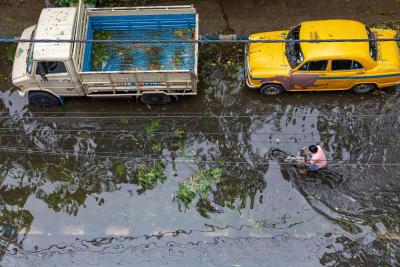Explained: What is climate change adaptation?


Climate change is no longer a distant prospect but a current reality across the globe. As impacts become more tangible, the term ‘climate change adaptation’ is increasingly cropping up. But there are different understandings, or definitions, of adaptation. And whether we recognize it or not, responding to climate change means choosing a definition, with profound consequences for who responds to climate change and how.
In short, climate change adaptation refers to 'the process of adjustment to actual or expected climate and its effects,' or how we deal with the impacts of climate change. Climate change adaptation is often contrasted with climate change mitigation, which refers to how we limit further changes in the climate in the first place. Adaptation could entail coastal cities addressing rising sea levels or farmers managing higher temperatures, while mitigation deals with reducing greenhouse gases in the atmosphere e.g. by planting trees or limiting the use of fossil fuels.
Adaptation means dealing with climate-related hazards, like slow-onset changes in rainfall patterns or sudden-onset storms. But the impact of a hazard depends on the context of where it hits. A drought in Denmark, for instance, will have different impacts than in Ethiopia. This is due to the differing physical, socio-economic and political contexts.
Adaptation - Adjustments to actual or expected climate and its effects.
Hazard – Climate-related physical events or trends or their physical impacts.
Vulnerability – Being predisposed to be negatively affected by climate change, linked to sensitivity and capacity to adapt.
Exposure – The physical presence of people, livelihoods, resources, etc. in places that could be negatively affected by climate change.
Definitions adapted from the Intergovernmental Panel on Climate Change’s Fifth Assessment Report.
Adaptation efforts can reduce exposure, or risks linked to the physical context, as well as vulnerability, or risks linked to the socio-economic and political context. Adaptation is often most pressing in the Global South. Societies in the Global South are physically more exposed to climate change hazards, which are generally concentrated around the equator, and they are typically more vulnerable, or predisposed to be negatively affected by climate change.
How to adapt is not always straightforward, though. Adaptation can cover a huge range of initiatives – from coastal protection infrastructure to new crop types to adjustments in government programs on social protection, agriculture and healthcare – all depending on the context and hazard. There are also different approaches to adaptation, often grouped into incremental, adjustment or transformative approaches. These define the problem to be addressed differently and therefore suggest different solutions and tools to get there. While incremental adaptation focuses on maintaining the status quo through technical solutions, transformative adaptation aims to address systemic issues that shape who experiences climate change and how. Adjustment adaptation lies in the middle. These different approaches highlight that adaptation requires choices of how to adapt that can be highly political.
Take the example of decreasing rainfall affecting rural water supply. An incremental perspective would focus on lack of water as the problem and look to irrigation or drought-resistant crops as solutions. A transformational perspective would define the problem differently to include underlying issues such as unequal water access, which make less rainfall especially problematic for some. A transformative approach would also entail changes in systems or processes, such as more inclusive water management and access.
Adaptation is increasingly urgent. Lagging global mitigation efforts suggest that the future need for adaptation will be immense. In this light, considering our definitions of adaptation – and the implications for adaptation efforts on the ground – becomes critical.
DIIS Experts

